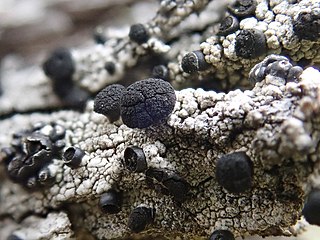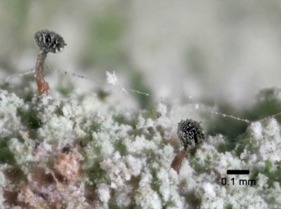
Calicium is a genus of leprose lichens. It is in the family Caliciaceae, and has 40 species.

Acolium is a genus of lichenized fungi in the family Caliciaceae. The genus has a widespread distribution and contains six species. These lichens are found on bark and wood, occasionally on rocks, or growing on other lichens.

Roccella is a genus of 23 species of lichens in the family Roccellaceae. The genus was circumscribed by Swiss botanist Augustin Pyramus de Candolle in 1805, with Roccella fuciformis as the type species.

Calicium abietinum, commonly known as fir pin or black stubble, is a crustose lichen that is found growing on trees throughout much of the world.
Calicium chlorosporum is a crustose lichen that is found growing on trees throughout much of the world.

Calicium viride, commonly known as the green stubble lichen, is a species of pin lichen in the family Caliciaceae, and the type species of the genus Calicium. It is a common and widely distributed species in temperate areas of the Northern Hemisphere and southern South America.

Allocalicium is a single-species fungal genus in the family Caliciaceae. It is monotypic, containing the single pin lichen species Allocalicium adaequatum. This lichen occurs in North America, South America, Europe, and the Russian Far East, where it grows on branches and twigs of deciduous trees and shrubs, typically those of alder and poplar. The species was originally described in 1869 as a member of Calicium, but molecular phylogenetics analysis demonstrated it was not a member of that genus and so Allocalicium was created to contain it.
Calicium episcalare is a rare species of pin lichen that is known from only a single locality in Sweden. It is in the family Caliciaceae. It one of the few Calicium species that is parasitic on another lichen. The type was found growing on the north-facing wall of an old wooden barn in Dalsland. The barn, which dates to the 17th century, was made from old pine wood and had likely never been painted. The specific epithet episcalare refers to the name of the host, Hypocenomyce scalaris, a common and widespread lichen. Calicium episcalare was described as a new species in 2016 by Swedish lichenologists Leif Tibell and Tommy Knutsson.
Pertusaria cerroazulensis is a species of corticolous (bark-dwelling), crustose lichen in the family Pertusariaceae. Found on the Galápagos Islands, it was formally described as a new species in 2015 by Frank Bungartz, Alan W. Archer, Alba Yánez-Ayabaca, and John Elix. The type specimen was collected from the Cerro Azul volcano at an altitude of 1,038 m (3,406 ft), where in a small, shaded woodland, it was growing on twigs of Psidium galapageium. The species epithet refers to the type locality.
Aspiciliopsis is a genus of lichen-forming fungi in the family Trapeliaceae. It has two species, both of which occur in the Southern Hemisphere.
Sirenophila cliffwetmorei is a species of saxicolous (rock-dwelling), crustose lichen in the family Teloschistaceae. It is found in Australia. Its thallus can reach up to 1 centimetre in width, has a whitish to whitish-grey colour, and is very thin, sometimes almost merging with the substrate, and has paler edges with a darker grey centre. Its numerous tiny apothecia give the thallus a yellow-orange appearance.
Lecidea lygommella is a species of saxicolous (rock-dwelling), crustose lichen in the family Lecideaceae. It spreads up to 7 cm wide with a thin thallus varying in colour from whitish and pale grey to rusty red-brown, featuring areolate surfaces with irregularly shaped areoles. Its fruiting bodies range from slightly embedded to sitting atop the thallus and black, flat to slightly convex apothecial discs. Unlike its lookalike Lecidea lygomma, L. lygommella does not produce any secondary chemicals. It is found in New South Wales and Victoria, Australia, where it grows on rocks in alpine areas.
Tetramelas gariwerdensis is a species of saxicolous (rock-dwelling), crustose lichen in the family Physciaceae, described in 2020. It is found in the Grampian Mountains in western Victoria, Australia.
Buellia lordhowensis is a little-known saxicolous (rock-dwelling), crustose lichen species in the family Caliciaceae, first described in 2020. It is only known to occur on Lord Howe Island, Australia.
Amandinea pilbarensis is a little-known species of crustose lichen in the family Physciaceae, First described in 2020, it is found in Australia. It is similar to Amandinea polyxanthonica, but can be distinguished by its smaller ascospores and the presence of calcium oxalate and thiophanic acid in the medulla.
Caloplaca akbarica, a species of lichen saxicolous (rock-dwelling), crustose lichen described in 2002. Found in Tajikistan, it has a rosette-shaped, lobate thallus, and apothecia that are distinctly pruinose. It was formally described as a new species in 2002 by the lichenologists Imomnazar Kudratov and Oleksandr Khodosovtsev.
Filsoniana ferdinandmuelleri is a species of saxicolous (rock-dwelling), crustose lichen in the family Teloschistaceae. It is found in Australia. The lichen has a squamulose (scaly) thallus, with a range of bright yellow to greenish-yellow and brownish-orange colours in its soredia and apothecia, respectively. The areoles of this lichen are varied in size, slightly raised from the thallus surface, and each carries one to four apothecia. The soralia are rounded or irregularly shaped, covering most of the thallus surface as a yellow to greenish-yellow mass. The apothecia have dark brownish-orange discs, surrounded by slightly paler yellow margins, with the spore-bearing asci containing typically eight brownish-golden ascospores.

Chaenothecopsis kilimanjaroensis is a species of lichenicolous (lichen-dwelling) pin lichen in the family Mycocaliciaceae. Found in the cloud forests of Tanzania, it was described as a new species in 2019. These tiny lichens have a short stalk, which can be either single or formed in aggregates on the same thallus. The stalks are medium brown at the base and become translucent in water. This species has unique spores, which contain a single septum, are arranged in a single row in the ascus, and have a surface ornamented with elongated, blister-like structures.
Marchantiana occidentalis is a species of corticolous and saxicolous, crustose lichen in the family Teloschistaceae. It is found in Western Australia, usually as an inhabitant of dry twigs, bark, or wood of various plant species, but occasionally on granite rock outcrops. It forms a well-developed thallus, shiny and composed of tiny dark greenish to brown areoles, with sizes typically ranging from 5–15 mm, though larger aggregations are possible. It features numerous rounded apothecia scattered across its surface, varying in form and colour, with a distinct margin and disc.
Buellia stellulata, commonly known as the disc lichen) is a species of crustose lichen that is widely distributed throughout the Northern Hemisphere.






